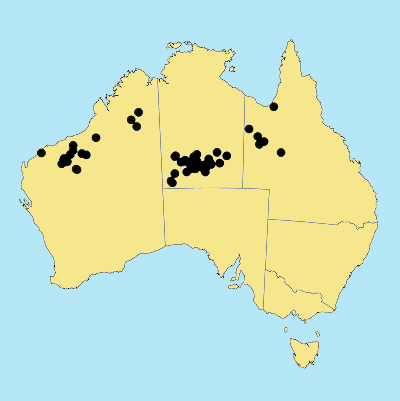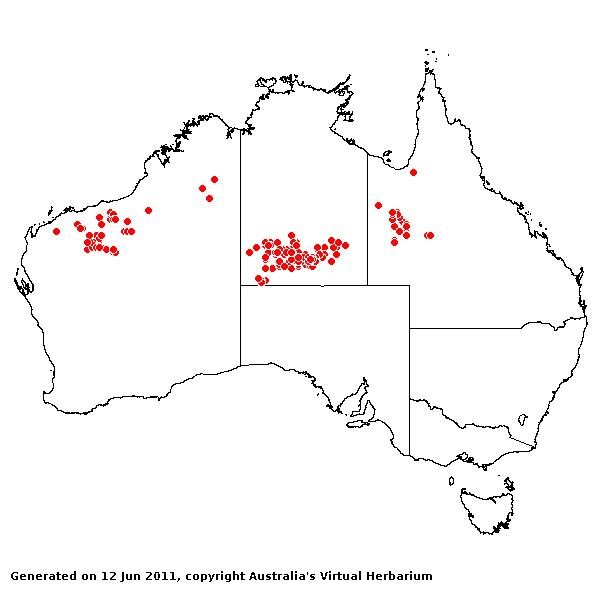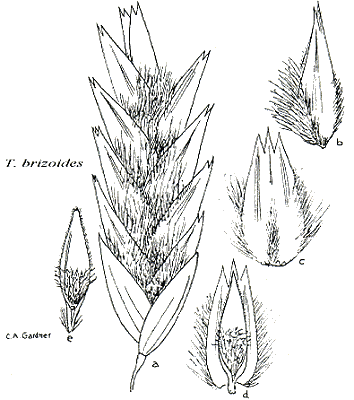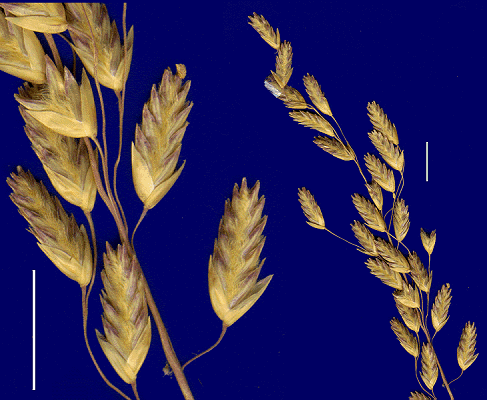Triodia brizoides N. T. Burbidge. Austral.
J. Bot. 1:161 (1953).
Classification. (GPWG 2001) : Subfamily
Chloridoideae. Triodeae.
Type of Basionym or
Protologue Information: Australia: Gorge Range, between Shaw and Coogan
Rivers, N.T. Burbidge 792 (HT: CAN; IT: BRI, PERTH).
Recent synonyms:
Triodia burkensis, Triodia clelandii.
Key references
(books and floras): [1952] C.A.Gardner, Flora of Western Australia 1
Gramineae (75), [1981] M.Lazarides in J.Jessop (ed)., Flora of
Central Australia (445 as T. clelandii), [2002] D.Sharp &
B.K.Simon, AusGrass, Grasses of Australia.
Illustrations:
[1952] C.A.Gardner, Flora of Western Australia 1 Gramineae (70,
Pl. 20).
Habit.
Perennial. Stolons present. Culms 30–150 cm tall. Mid-culm internodes glabrous.
Leaf-sheaths glabrous on surface. Leaf-sheath auricles absent. Ligule a fringe
of hairs. Leaf-blades straight, aciculate, conduplicate, 3–20 cm long, 0.6–1 mm
wide.
Inflorescence.
Inflorescence compound, a panicle. Panicle linear or elliptic, effuse, 5–17 cm
long. Racemes 1.
Spikelets.
Spikelets pedicelled. Fertile spikelets many flowered, with at least 2 fertile
florets (7–10), comprising 7–10 fertile floret(s), with diminished florets at
the apex, oblong, laterally compressed, 8–22 mm long.
Glumes.
Glumes similar, thinner than fertile lemma. Lower glume oblong, scarious or
cartilaginous or indurate, without keels, 3–5 -nerved. Lower glume surface glabrous.
Lower glume apex muticous or mucronate. Upper glume oblong, 4–10 mm long,
scarious or cartilaginous or indurate, without keels, 3–5 -nerved. Upper glume
surface glabrous. Upper glume apex entire, muticous or mucronate.
Florets.
Fertile lemma 4.5–7(–10) mm long, without keel or keeled, 9 -nerved. Lemma
surface indumented. Lemma apex dentate or lobed. Anthers 3.
Continental
Distribution: Australasia.
Australian
Distribution: Western Australia, Northern Territory, Queensland.
Western Australia:
Hall. Canning, Fortescue. Northern Territory: Central Australia North,
Central Australia South. Queensland: Burke, Gregory North, Mitchell.
Notes.
T. brizoides is treated in the broader sense, including the more
recently described T. burkensis and T. clelandii, as the
characters used to distinguish the taxa have been found to be variable.
Occurs
disjunctly between 17°S and 26°S in W.A., N.T. and Qld, and from the W.A. coast
to 141°04'E. Predominantly in skeletal, rocky or stony soils on hills, ranges,
foothills, ridges, scree slopes and outcrops in association chiefly with
quartzite, sandstone, laterite and limestone, but also with shale, basalt and
metamorphic rocks; less frequently on sand plains, sandy river channels and
banks, deep red earths and clays, and sandy loams; flowers all seasons; fruits
all seasons.





